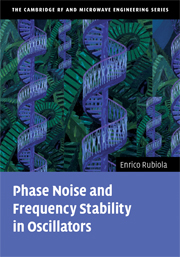Book contents
- Frontmatter
- Contents
- Foreword by Lute Maleki
- Foreword by David Leeson
- Preface
- Notation
- 1 Phase noise and frequency stability
- 2 Phase noise in semiconductors and amplifiers
- 3 Heuristic approach to the Leeson effect
- 4 Phase noise and feedback theory
- 5 Noise in delay-line oscillators and lasers
- 6 Oscillator hacking
- Appendix A Laplace transforms
- References
- Index
2 - Phase noise in semiconductors and amplifiers
Published online by Cambridge University Press: 24 January 2011
- Frontmatter
- Contents
- Foreword by Lute Maleki
- Foreword by David Leeson
- Preface
- Notation
- 1 Phase noise and frequency stability
- 2 Phase noise in semiconductors and amplifiers
- 3 Heuristic approach to the Leeson effect
- 4 Phase noise and feedback theory
- 5 Noise in delay-line oscillators and lasers
- 6 Oscillator hacking
- Appendix A Laplace transforms
- References
- Index
Summary
Understanding amplifier phase noise is vital to the comprehension of oscillators. There are two basic classes of noise, additive and parametric, as illustrated in Fig. 2.1. However, their behavior, and the underlying physical mechanisms, are strikingly different. This chapter focuses on amplifiers but includes a few words on the photodetector, which forms part of the resonator–amplifier loop in the emerging photonic (or optoelectronic) oscillators. The same principles apply to other electronic and optoelectronic components.
Random noise is normally present in electronic circuits. When such noise can be represented as a voltage or current source that can be added to the signal, it is called additive noise. Another mechanism can be present, referred to as parametric noise, in which a near-dc process modulates the carrier in amplitude, in phase, or in a combination thereof. The most relevant difference is that additive noise is always present, while parametric noise requires nonlinearity and the presence of a carrier. Additive noise is generally white, while parametric noise can have any shape around ν0, depending on the near-dc phenomenon. Additive noise originates in the region around the carrier frequency ν0 while parametric noise is brought there from near-dc by the carrier. This is made evident by a gedankenexperiment (thought experiment) in which we inspect the amplifier output around ν0 with an ideal spectrum analyzer, switching the input carrier on and off.
- Type
- Chapter
- Information
- Phase Noise and Frequency Stability in Oscillators , pp. 35 - 66Publisher: Cambridge University PressPrint publication year: 2008
- 1
- Cited by

